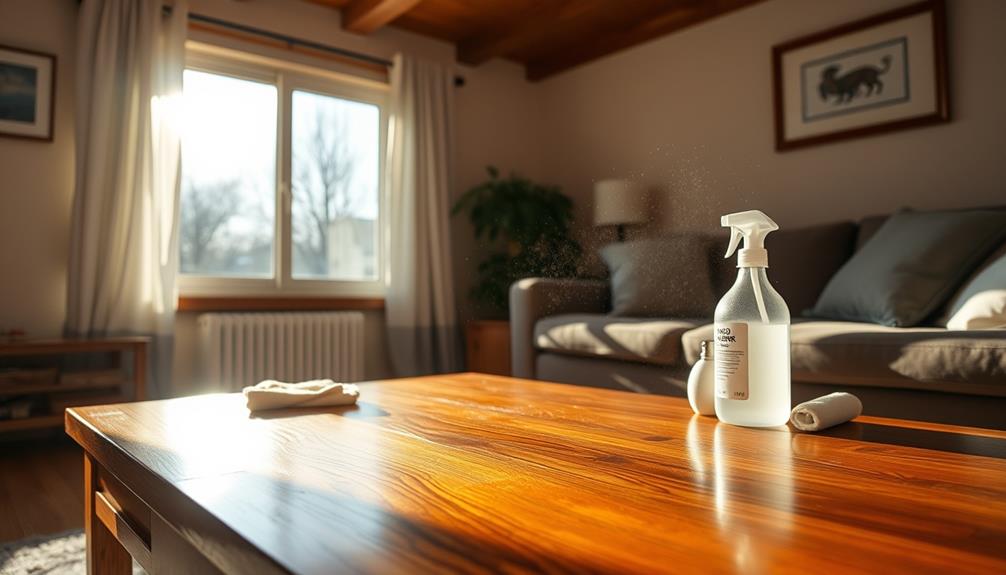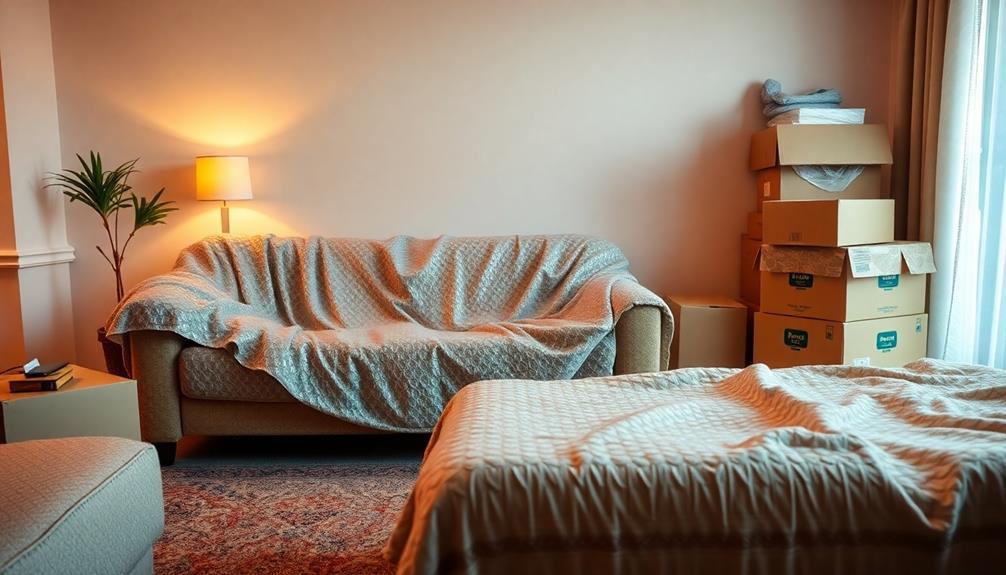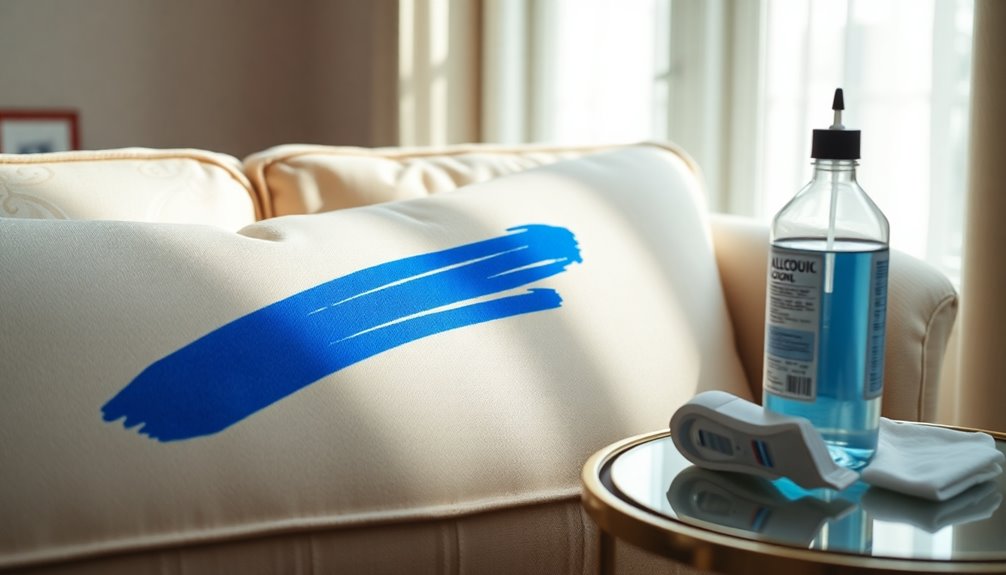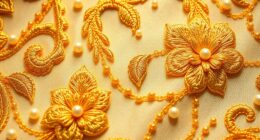To maintain the cleanliness of wood furniture, make sure to dust it on a weekly basis using a microfiber cloth to prevent any buildup. For a more thorough cleaning, you can create a solution by mixing mild dish soap with warm water and using a slightly damp cloth, always moving in the direction of the wood grain. It is important to avoid using harsh cleaners or excessive moisture, as they can potentially harm the wood. In case of stubborn stains, consider making a baking soda paste or using a low-temperature iron with a cloth to remove heat marks. To keep your furniture looking its best, polish it every 6-8 weeks using natural solutions such as olive oil and white vinegar. If you’re interested in learning more tips and tricks for preserving your wood furniture, there’s a wealth of information waiting to be explored.
Key Takeaways
- Regularly dust wood furniture with a microfiber cloth to prevent grime buildup and preserve its finish.
- Use a mixture of mild dish soap and warm water for deeper cleaning, applying with a slightly damp cloth.
- Avoid abrasive cleaners and harsh chemicals that can scratch surfaces and strip protective finishes.
- Wipe up spills immediately with a dry cloth to prevent moisture damage and stains.
- Polish furniture every 6-8 weeks with natural wood polish to enhance shine and protect surfaces.
How Often to Clean
When it comes to keeping your wood furniture looking its best, regular cleaning is key. You should start with weekly dusting to prevent dust and dirt buildup on surfaces. This simple step not only keeps your furniture looking fresh but also aids in maintaining the beauty of your pieces.
Additionally, incorporating professional cleaning services can further enhance the longevity of your furniture. Use a soft cloth or microfiber duster to gently wipe down all surfaces, paying special attention to corners and crevices.
In addition to weekly dusting, you'll want to commit to monthly cleaning and polishing. This deeper level of care helps preserve the integrity of the wood and extends its lifespan. Choose a suitable wood cleaner and apply it with a soft cloth, following up with a polish to enhance shine and protect the finish.
Don't overlook areas of concern, such as scratches or stains. Addressing these issues early can prevent larger problems down the line.
Cleaning Materials to Avoid
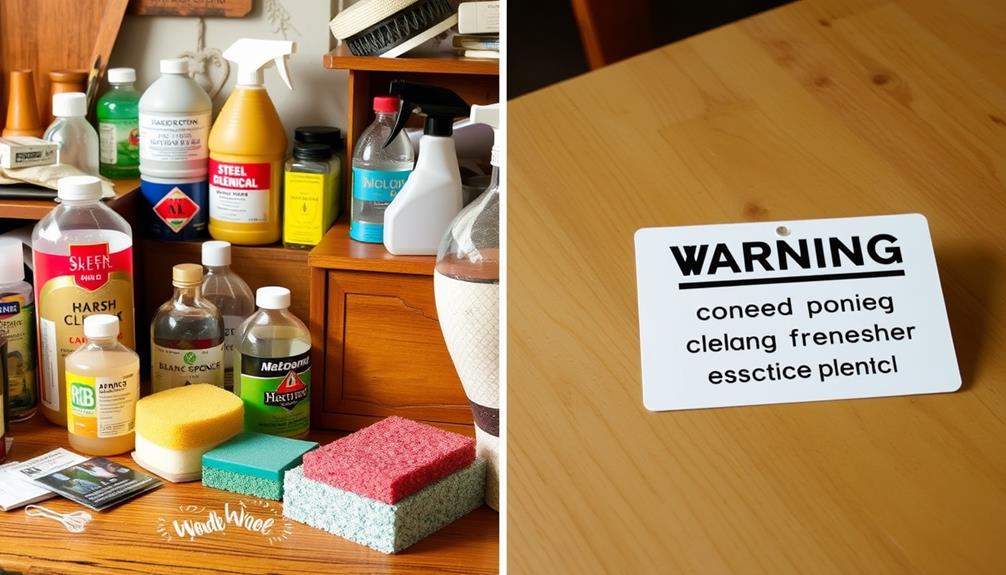
When cleaning wood furniture, it's essential to avoid certain materials that can cause serious damage. Steer clear of abrasive cleaners, harsh chemicals, and excessive moisture, as these can scratch surfaces, strip finishes, and warp the wood.
Additionally, using natural products like essential oils can offer a gentle cleaning solution while maintaining the beauty of your furniture. For instance, essential oils for respiratory health can be a great alternative to harsh chemicals.
Harmful Chemical Ingredients
To keep your wood furniture looking its best, it's essential to steer clear of harmful cleaning materials. Harsh chemicals can strip away the protective finishes that safeguard your wood from moisture, leading to warping and unsightly water stains.
Additionally, using toilet maintenance tips can help you understand how proper care extends to other household items, including furniture. You should avoid abrasive cleaners, as they can scratch the surface, causing permanent damage and dulling the finish.
Acidic products, like vinegar, may seem like a natural cleaning solution, but they can actually lighten and dry out the wood. Full-strength vinegar is particularly unsafe, as its high acidity can erode the finish and result in discoloration. These effects compromise the structural integrity and appearance of your furniture.
When selecting cleaning methods, always opt for gentle alternatives that help protect wood rather than risking its beauty.
Effects of Excess Moisture
Harmful cleaning products aren't the only threat to your wood furniture; excess moisture can also wreak havoc.
When you use overly wet materials, you're risking unsightly water stains that can be tough to remove from wood surfaces. Even a damp cloth left on your furniture for too long can lead to significant problems like mold growth or deterioration.
Moisture can warp wood, altering the shape of your beloved pieces and leading to structural damage. High humidity levels can worsen these effects, increasing the risk of wood swelling and joint separation.
You might think you're being careful, but continuous exposure to moisture can cause finishes to blister or peel, compromising the protective layer meant to keep your furniture looking great.
To clean wood furniture effectively, avoid using excessive water or leaving damp cloths on surfaces for extended periods. Instead, opt for a slightly damp cloth when necessary, and always dry the area promptly.
Risks of Abrasive Cleaners
What could be more damaging to your wood furniture than abrasive cleaners? These harsh products can leave your beloved pieces scratched and unsightly, ruining their aesthetic appeal.
When you use abrasive materials, you risk stripping away protective finishes that keep moisture and stains at bay. This exposure can lead to irreversible damage over time, making your furniture more susceptible to warping and cracking.
Here are some cleaning materials you should avoid:
- Steel wool: This can easily scratch the surface of wood.
- Scouring pads: They're too harsh and can ruin the finish.
- Bleach-based cleaners: These can discolor and dull the natural shine.
- Abrasive powders: They can cause permanent scratches and damage.
Instead, opt for gentle cleaning methods that will maintain the beauty and longevity of your wood furniture.
Use soft cloths and mild soap solutions to clean without risking further damage. By avoiding abrasive cleaners, you’ll guarantee your furniture remains protected and looking its best for years to come. Additionally, it’s important to regularly assess your furniture for any signs of wear or damage, addressing these issues promptly to extend its lifespan. When the time comes to upgrade or replace pieces, remember to dispose of unwanted furniture safely, ensuring that it doesn’t end up in a landfill. You can consider donating usable items or recycling materials, which not only helps the environment but also supports your community.
Basic Cleaning Techniques
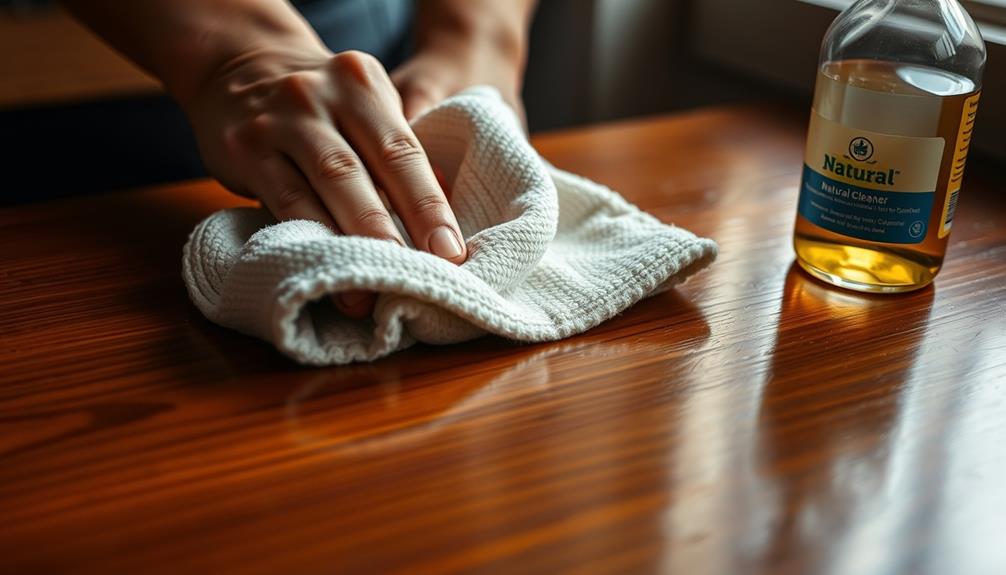
Keeping your wood furniture clean is straightforward with just a few essential techniques. Start with regular dusting using a soft microfiber cloth. This will help prevent the buildup of dirt and grime on your furniture surfaces. Aim to dust at least once a week, or more often if you notice dust accumulating.
For deeper cleaning, mix a few drops of mild dish soap with warm water. Dampen a soft cloth with this solution, but make sure it's not overly saturated. Gently wipe down the furniture, taking care to follow the wood grain.
After cleaning, it's vital to dry the wood furniture thoroughly with a dry cloth to avoid water spots and moisture damage.
Before using any new cleaning solution, test it on an inconspicuous area first. This way, you can verify it won't harm the finish or color of your furniture.
Remember to avoid abrasive cleaners or acidic products, as they can scratch or damage the wood's surface. By following these basic cleaning techniques, you'll maintain the beauty and longevity of your wood furniture.
Removing Stains and Marks
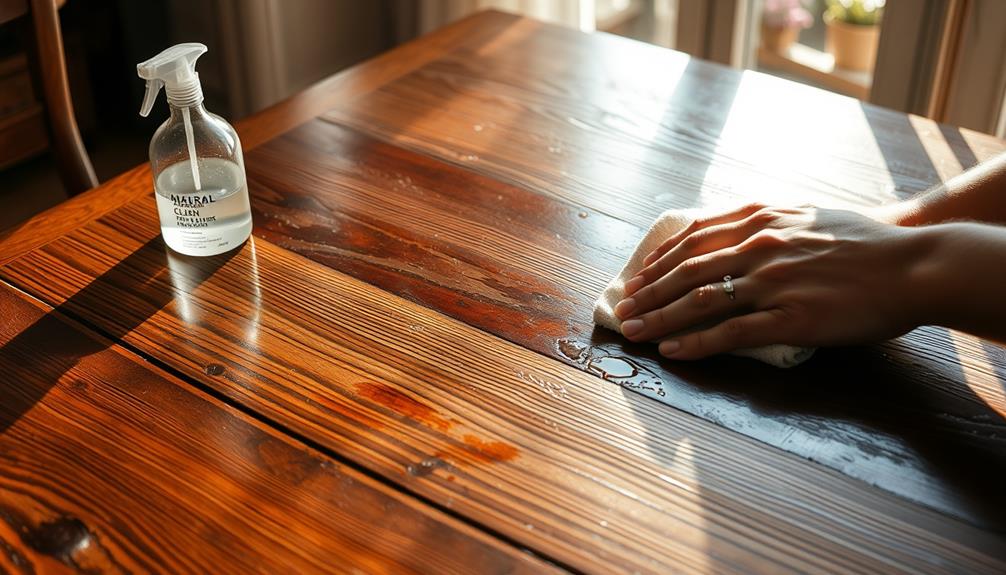
When it comes to removing stains and marks from wood furniture, knowing the common types of stains is key to choosing the right cleaning technique.
You'll find that different stains require specific methods, whether it's heat, moisture, or ink.
Common Stain Types
Wood furniture is beautiful but can easily fall victim to various stains and marks. Knowing how to identify and treat these common stains can help preserve its charm. Here are a few types you might encounter:
- Water stains: These can often be removed by making a paste with baking soda and water. Gently rub it along the wood grain for the best results.
- Heat marks: To treat these, place a white cloth over the stain and use a low-temperature iron, checking the progress frequently to avoid further damage.
- Ink stains: For ink marks, create a paste from baking soda and water, applying it gently with a soft cloth to lift the stain without scratching the surface.
- Grease stains: Sprinkle cornstarch over the affected area to absorb the grease. Allow it to sit before brushing it off and cleaning the surface.
If you're dealing with dark stains, a hydrogen peroxide solution may be necessary. Apply it to the area, let it sit for 10-15 minutes, then wipe off and dry thoroughly.
Understanding these stains is the first step toward effective cleaning!
Effective Cleaning Techniques
To effectively clean stains and marks from your wood furniture, it's crucial to act promptly. Start by addressing surface dirt with dry dusting using a microfiber cloth.
For heat stains, place a white cloth over the stain and gently iron it on a low setting, checking frequently to avoid damaging the wood. If you need to remove water stains, apply denatured alcohol with a soft cloth, letting it sit for 10-15 minutes before drying it off.
For dark stains, a hydrogen peroxide solution can be effective; apply it directly and let it sit for about the same duration before wiping away.
Ink stains require a paste made of 1 tablespoon of baking soda and 1 teaspoon of water. Gently apply it to the stain and wipe off with a clean damp cloth.
For stubborn stains, non-gel toothpaste can be used—rub it with a soft cloth until the stain lifts, then wipe it off with a damp cloth and thoroughly dry the surface.
These tips for cleaning wood will help you maintain the beauty of your furniture without causing any damage.
Preventive Measures for Stains
One of the best ways to keep your wood furniture looking pristine is by taking preventive measures against stains and marks. Start by using coasters for drinks and avoid placing hot items directly on wood surfaces. This minimizes heat marks and moisture damage, which can be problematic.
Incorporate these simple habits into your routine:
- Regularly dust your furniture with a soft, slightly damp clean cloth to prevent the buildup of abrasive particles.
- Immediately wipe up spills with a clean, dry cloth to stop moisture from seeping into the wood.
- Apply a natural wood polish every 6-8 weeks to enhance shine and create a protective barrier.
- Keep your furniture out of direct sunlight to prevent fading and discoloration, making stains less noticeable.
Homemade Cleaning Solutions
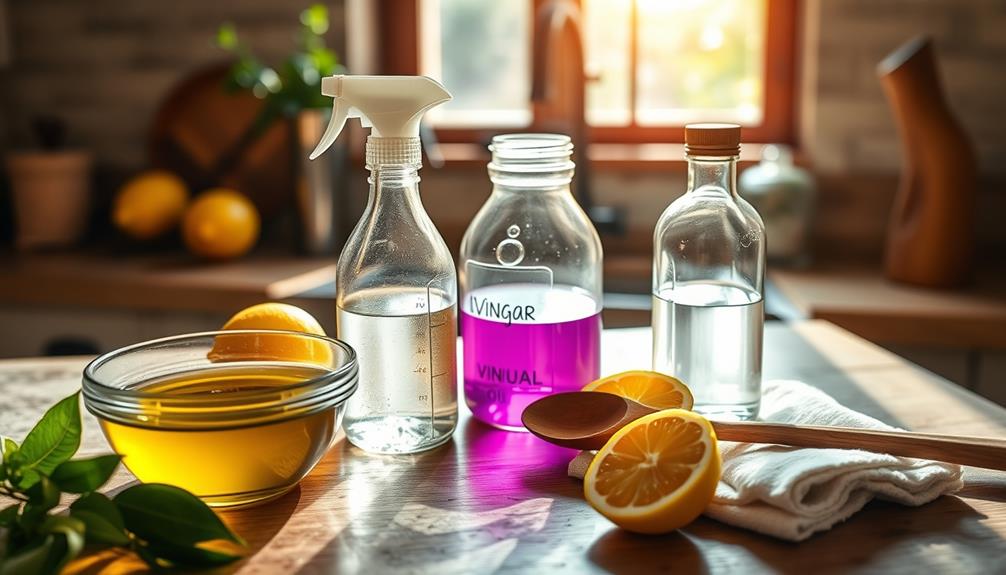
Creating effective homemade cleaning solutions for your wood furniture can be both simple and rewarding. To clean wood furniture without damaging it, mix 1 cup of olive oil with 1/4 cup of white vinegar. This solution not only cleans but also conditions the wood, leaving it shiny and nourished.
For a gentler approach, combine warm water with a few drops of mild dish soap. Just make certain your soft cloth is damp, not wet, to avoid excess moisture on the wood.
If you're looking for a natural polish, steep two tea bags in boiling water and let it cool. The tannic acid in tea enhances shine, making it a great cleaning solution.
For ink stains, create a paste with 1 tablespoon of baking soda and 1 teaspoon of water. Gently rub it with a soft cloth to lift the stain.
Before using any homemade solution, always test on an inconspicuous area first. This guarantees it won't adversely affect your wood finish.
With these homemade options, you can keep your wood furniture looking great while using safe, natural ingredients.
Tips for Maintenance
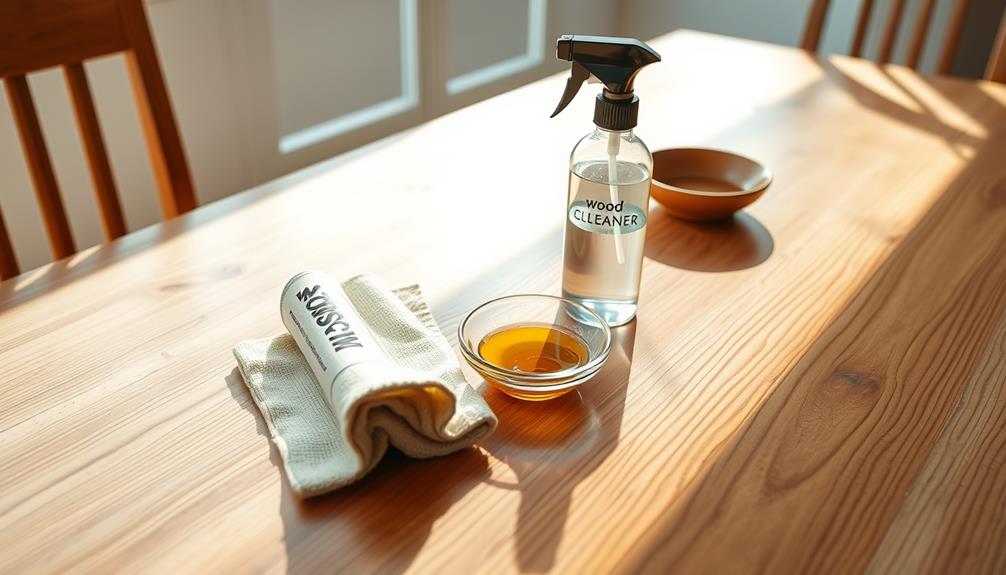
Maintaining the beauty of your wood furniture requires consistent care and attention. By following a few simple steps, you can clean your wood furniture without damaging it and guarantee it stays in great shape for years to come.
- Regularly dust with a soft, dry microfiber towel to prevent dirt buildup.
- Use coasters for beverages and placemats for hot dishes to help protect surfaces.
- Polish your furniture every 6-8 weeks with natural conditioners for added shine.
- Clean up spills immediately to prevent moisture damage that can warp or stain.
Keeping your wood furniture out of direct sunlight is also essential, as it can fade and degrade the finish over time.
By implementing these tips, you'll not only maintain the appearance of your wood furniture but also extend its lifespan.
Remember, a little effort goes a long way in preserving the beauty of your pieces. Regular maintenance will guarantee that your furniture continues to be a stunning focal point in your home.
Myths About Wood Cleaning
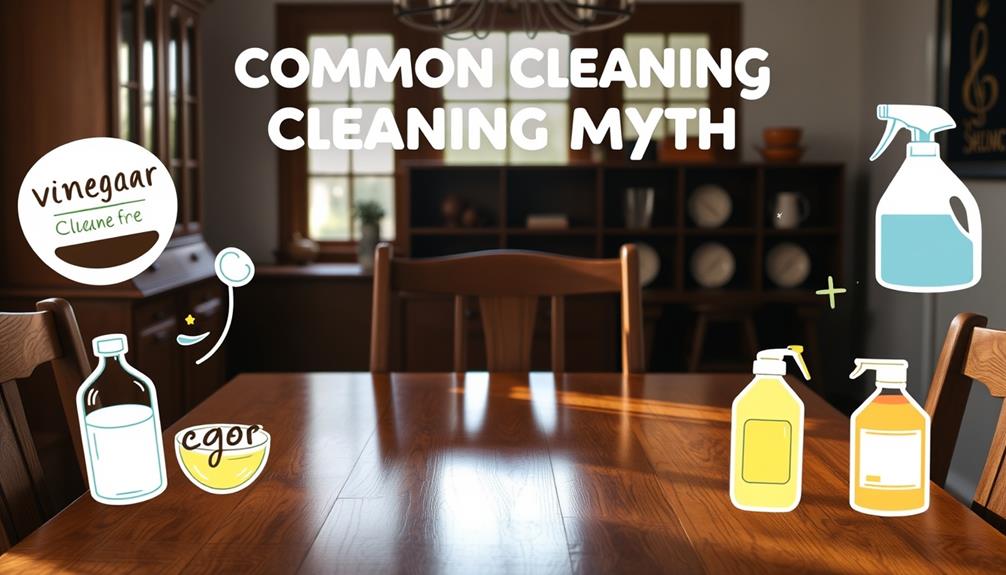
When it comes to cleaning wood furniture, several myths can lead to confusion and improper care. One common misconception is that only oil soap is safe for wood surfaces. In reality, many gentle soap solutions can effectively clean wood furniture without damaging finishes.
You might also think you should never use water on wood, but you can use it sparingly if you dry the surface properly to avoid water rings.
Another myth is that you need specialty cleaning products for wood. A mild dish soap mixed with water is often a safer and effective alternative.
Many people mistakenly believe vinegar is a safe green cleaner for wood, but its acidity can actually lighten and dry out the wood.
Lastly, some homeowners think regular polishing is essential to keep wood from drying out. Instead, consistent dusting and cleaning are more important for maintaining your furniture's beauty.
Frequently Asked Questions
What Is the Best Thing to Clean Wood Furniture With?
To clean wood furniture effectively, you'll want to use a gentle, pH-neutral solution like mild dish soap mixed with warm water. Microfiber cloths work best to trap dust without scratching the surface. Avoid acidic cleaners.
How Do You Clean Old Wood Furniture Without Damaging the Finish?
To clean old wood furniture without damaging the finish, you'll want to dust with a soft cloth, use a damp soapy cloth carefully, and test any cleaner on an inconspicuous area first. Avoid harsh chemicals.
Can You Use Vinegar to Clean Wood Furniture?
Vinegar's allure may shimmer like a mirage, but it'll erode your wood's beauty instead. You shouldn't use it; try gentle cleaners or a diluted olive oil mixture to preserve your furniture's luster and integrity.
What Is the Best Product to Clean Old Wood Furniture With?
When cleaning old wood furniture, you'll want to use a gentle wood-specific cleaner like Bona or a DIY mix of olive oil and vinegar. Always test products first to verify they're safe for your furniture.
Conclusion
In the dance of dust and shine, keeping your wood furniture looking its best isn't just a chore; it's a joyful ritual. Picture the warm glow of polished surfaces reflecting your care, transforming your living space into a cozy haven. By following these cleaning tips and using the right materials, you'll protect your pieces from wear and tear. So, grab that soft cloth and let your furniture shine, reminding you of the beauty in your everyday surroundings.
